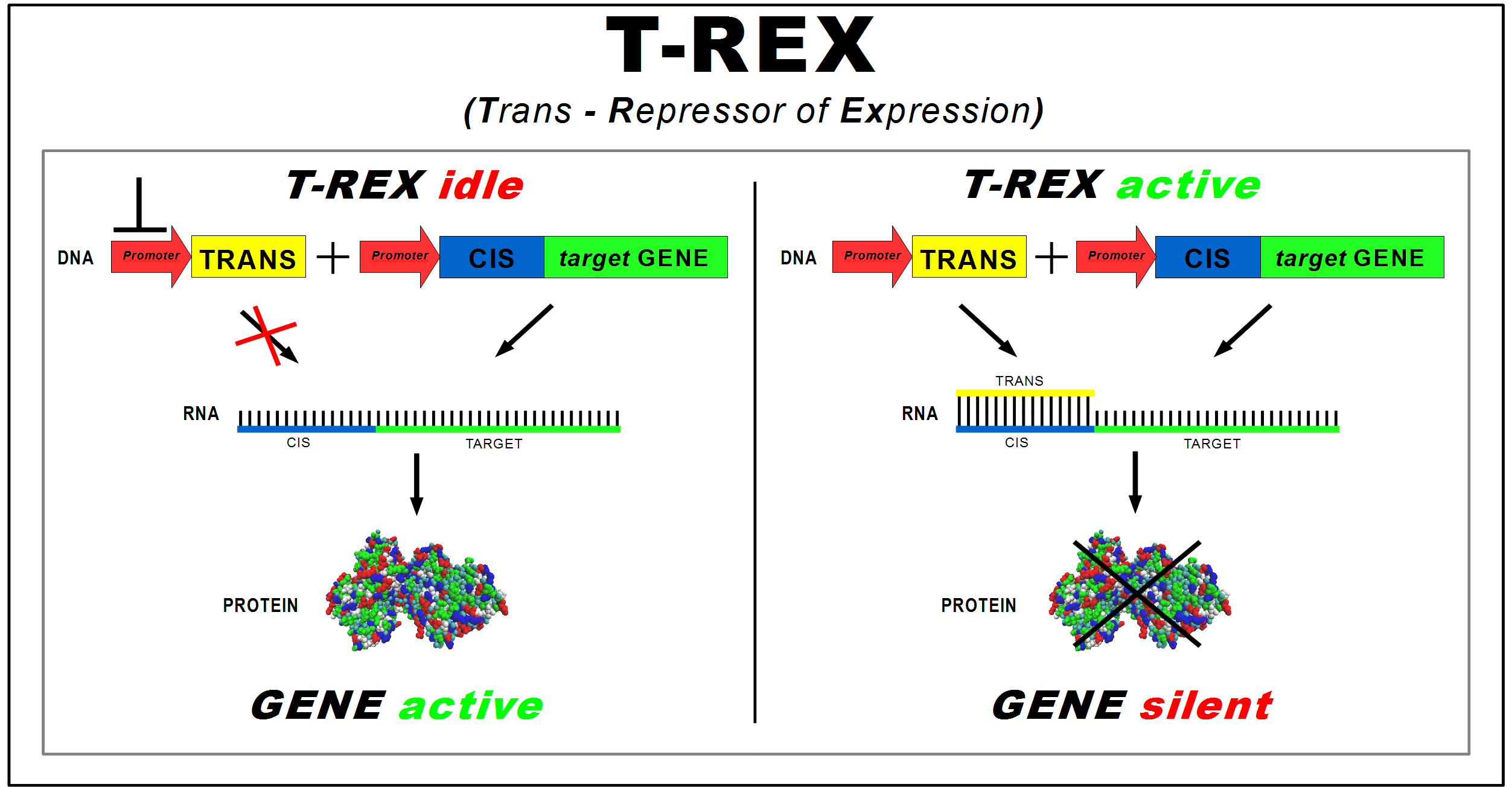Team:Bologna
From 2009.igem.org
Marco.cavina (Talk | contribs) |
Marco.cavina (Talk | contribs) |
||
| Line 8: | Line 8: | ||
<div style="text-align:justify"> | <div style="text-align:justify"> | ||
| - | = Project | + | = Project Summary = |
'''Which is our idea?''' | '''Which is our idea?''' | ||
| - | + | The project aims to implement a protein synthesis regulation system in Escherichia coli that is independent from regulated protein and acting at translational level, to make the control action faster. This "general-purpose" device was named '''T-Rex''' ('''T'''rans '''R'''epressor of '''Ex'''pression). It consists of two new BioBricks: '''Trans-repressor''' and '''Cis-repressing'''. | |
| Line 18: | Line 18: | ||
'''How can we achieve this?''' | '''How can we achieve this?''' | ||
| - | + | The TRANS-repressor is a non-coding DNA sequence, the transcript of which acts as a silencer of the CIS-repressing RNA target. This target includes a region complementary to the sequence of the TRANS-repressor antisense, ends with a ribosome binding site (RBS), and is assembled upstream of the coding sequence of the gene to be silenced. Upon binding of TRANS-repressor and CIS-repressing RNAs, the access to RBS by ribosomes is hampered, silencing translation from the downstream transcript. Accordingly, the amount of TRANS-repressor controls the translation rate of the regulated gene. | |
| - | + | <br> | |
| + | The TRANS-repressor sequence was determined by a computational analysis performed to minimize the interference with the genomic mRNAs and to maximize the base-pairing interaction to the CIS-repressing RNA. | ||
| Line 28: | Line 29: | ||
'''What can we use it for?''' | '''What can we use it for?''' | ||
| - | + | We developed a circuit in order to test and characterize our T-Rex device: | |
| - | + | ||
| - | + | ||
| - | + | ||
| - | + | ||
| - | + | ||
| - | + | ||
| - | + | ||
| - | + | ||
<br> | <br> | ||
| - | + | [[Image:circuit2.jpg|center|900px|]] | |
| - | + | ||
| - | + | ||
<br> | <br> | ||
The T-REX device is proposed as a universal and fast switch in synthetic gene circuits. | The T-REX device is proposed as a universal and fast switch in synthetic gene circuits. | ||
| + | |||
| + | More details about our work in the [[Team:Bologna/Project|Project]] section. | ||
Revision as of 10:33, 14 October 2009
| HOME | TEAM | PROJECT | SOFTWARE | MODELING | WET LAB | PARTS | HUMAN PRACTICE | JUDGING CRITERIA |
|---|
Project Summary
Which is our idea?
The project aims to implement a protein synthesis regulation system in Escherichia coli that is independent from regulated protein and acting at translational level, to make the control action faster. This "general-purpose" device was named T-Rex (Trans Repressor of Expression). It consists of two new BioBricks: Trans-repressor and Cis-repressing.
How can we achieve this?
The TRANS-repressor is a non-coding DNA sequence, the transcript of which acts as a silencer of the CIS-repressing RNA target. This target includes a region complementary to the sequence of the TRANS-repressor antisense, ends with a ribosome binding site (RBS), and is assembled upstream of the coding sequence of the gene to be silenced. Upon binding of TRANS-repressor and CIS-repressing RNAs, the access to RBS by ribosomes is hampered, silencing translation from the downstream transcript. Accordingly, the amount of TRANS-repressor controls the translation rate of the regulated gene.
The TRANS-repressor sequence was determined by a computational analysis performed to minimize the interference with the genomic mRNAs and to maximize the base-pairing interaction to the CIS-repressing RNA.
What can we use it for?
We developed a circuit in order to test and characterize our T-Rex device:
The T-REX device is proposed as a universal and fast switch in synthetic gene circuits.
More details about our work in the Project section.
Acknowledgements
- [http://www.unibo.it/Portale/default.htm University of Bologna]
- [http://serinar.criad.unibo.it Ser.In.Ar. Cesena]
 "
"





